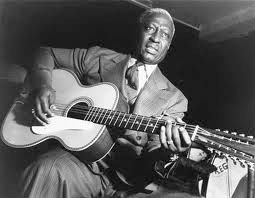Last Updated on August 22, 2013 by Honeyboy
Alan Lomax, and his father John before him, were heavily responsible for bringing the origins of the blues to light. They traveled rural, southern America looking for “folk” artists and stories throughout much of the 20th century. Their most famous “subject” and recording was of Huddie Leadbetter, better known as Leadbelly, at Angola Prison in 1934. They went on to record many of the blues “songsters” and black folk musicians of Luisiana, Mississippi, and Texas and many other southern states.
They did this as part of a project for a New York publisher and The Library of Congress, who committed to helping him create an anthology of American Folk and Blues music and history. They traveled throughout the south to plantations, lumber camps, prisons, and “barrel-houses” in hopes of finding authentic American folk music of all kinds. They used an Edison metal cylinder machine to record what they found.

Huddie Ledbetter – “Leadbelly”
These were not formal recording sessions in any way. They were often made in hotel rooms or “on location” in prisons and homes and anywhere a musician could be pinned downed long enough to get them to perform. And the music they recorded ran the gamut from prison songs, works songs, reels, blues, ballads, and barrel-house ditties. These were not professional entertainers as such, just locals who played the music for self-entertainment and might be described as “songsters” or performers who played any and everything.
Other “folklorists” had done the same thing before them, including Robert W. Gordon and Lawrence Ellert beginning in 1924. But these weren’t as extensive as the Lomax’s recordings. Much of what they recorded ended up in the Library of Congress in Washington, D.C.
Now every piece of recordings that Alan did, and particularly what Alan did in subsequent “field trips” from the 40’s on, is now available online for free. You can find these recordings here.
These Are Not Commercial Recordings
Other recordings had been made by companies trying to sell music to blacks and lovers of blues. So these are not the first, or even the best of this type of early blues recording. But they are very extensive and they do catalog the music of the times at the rural roots level.
Alan Lomax recorded a staggering amount of folk music. He worked from the 1930s with his father, and into the ’90s on his own, and traveled from the Deep South to the mountains of West Virginia, all the way to Europe, the Caribbean and Asia. When it came time to bring all of those hours of sound into the digital era, the people in charge of the Lomax archive weren’t quite sure how to tackle the problem.
But Lomax’s vision was to create a Global Jukebox that would make it easy to compare music across different cultures and continents using a complex analytical system he devised — kind of like Pandora for grad students. But the fundamental idea was simple: Make it all available to anyone, anywhere in the world. His goal was to spread folk culture wherever it may live.
Thanks to many volunteers who believed in his vision, all of his recordings are now freely available online. Most of Lomax’s original recordings and notes are now stored at the Library of Congress in Washington, D.C. But according to Don Fleming, executive director of the Association for Cultural Equity, Lomax’s vision is coming true.
“For the first time, everything that we’ve digitized of Alan’s field recording trips are online, on our website,” says Fleming. “It’s every take, all the way through. False takes, interviews, music.”
If you’d like to dig into the history of the blues and American folk culture you can go to his website and give a listen.
You can also find more of the story here on the National Public Radio site.


